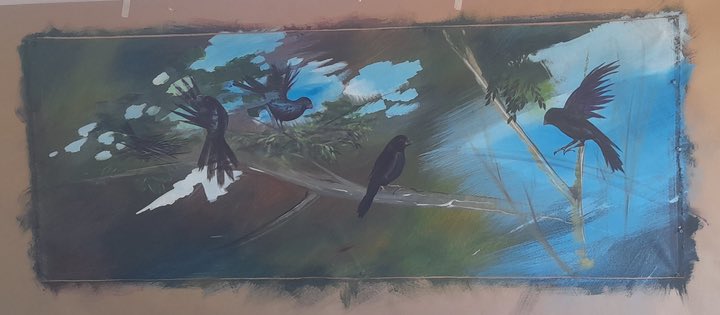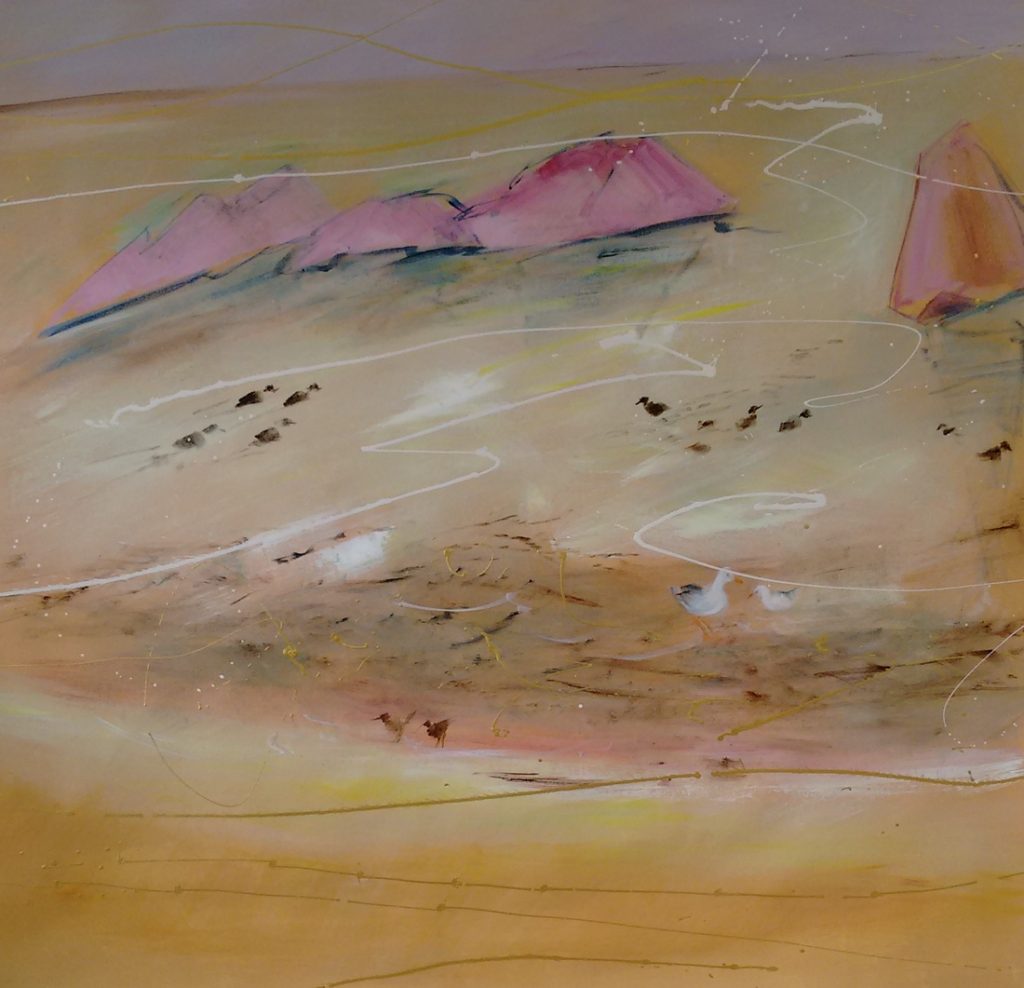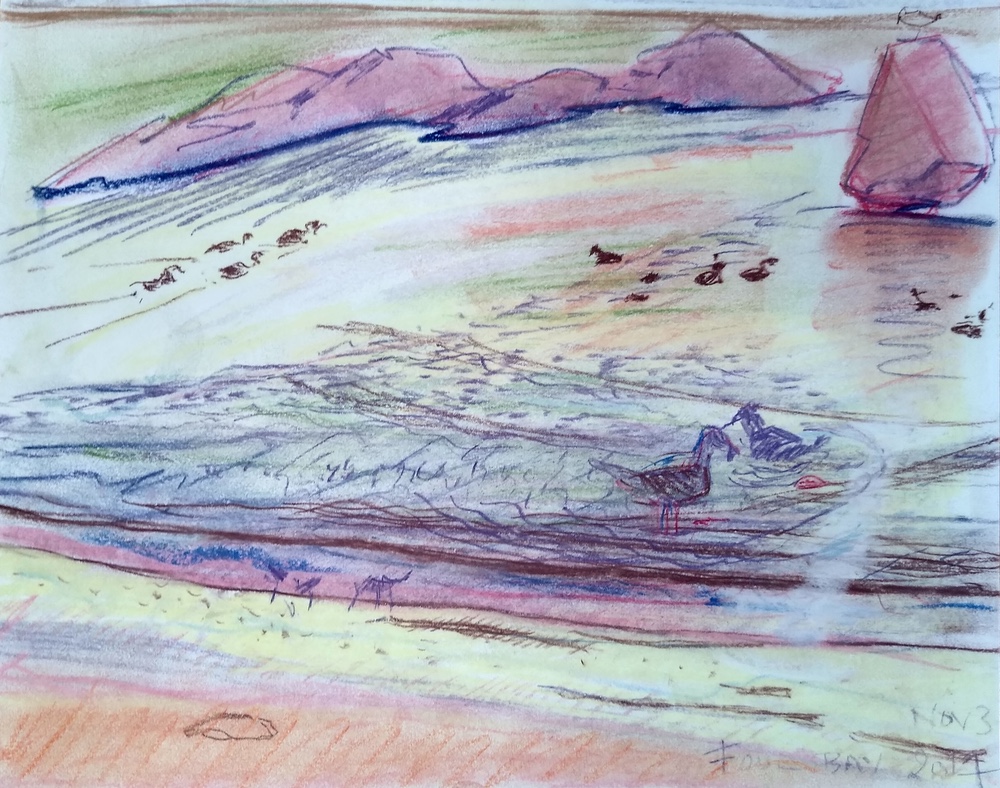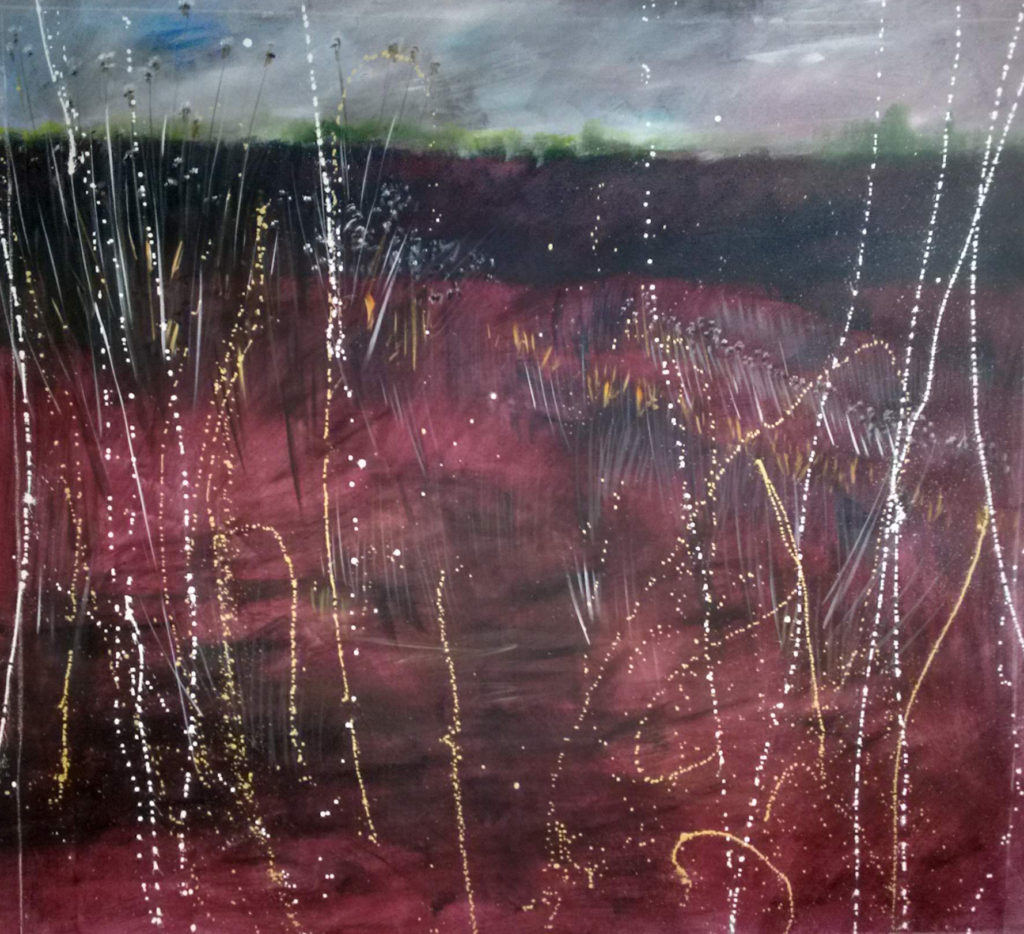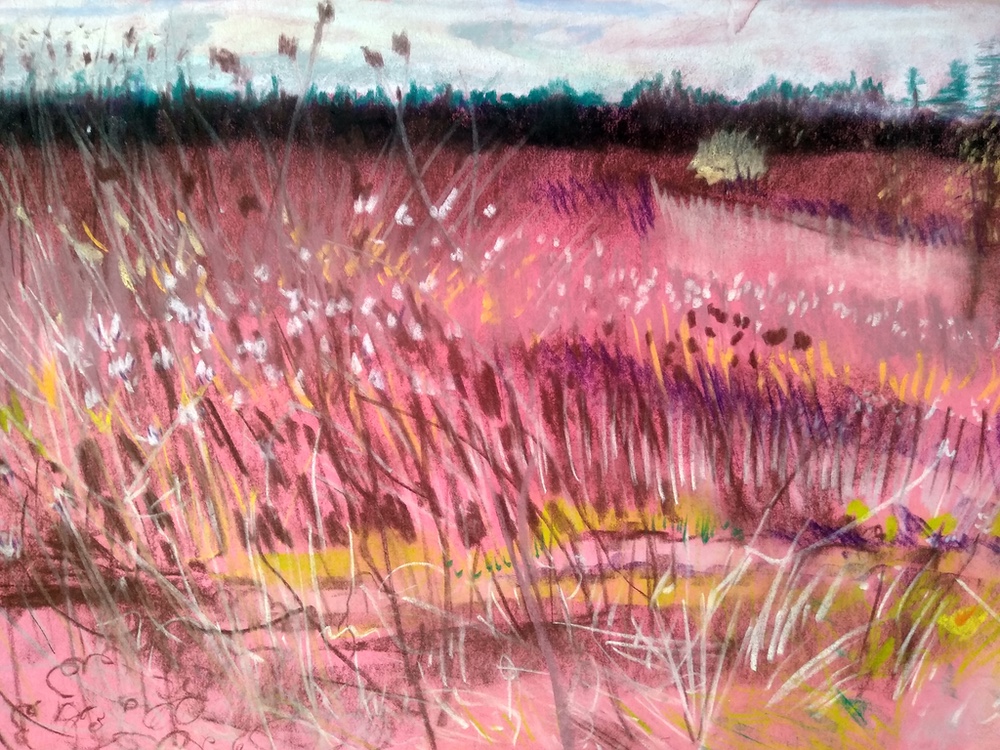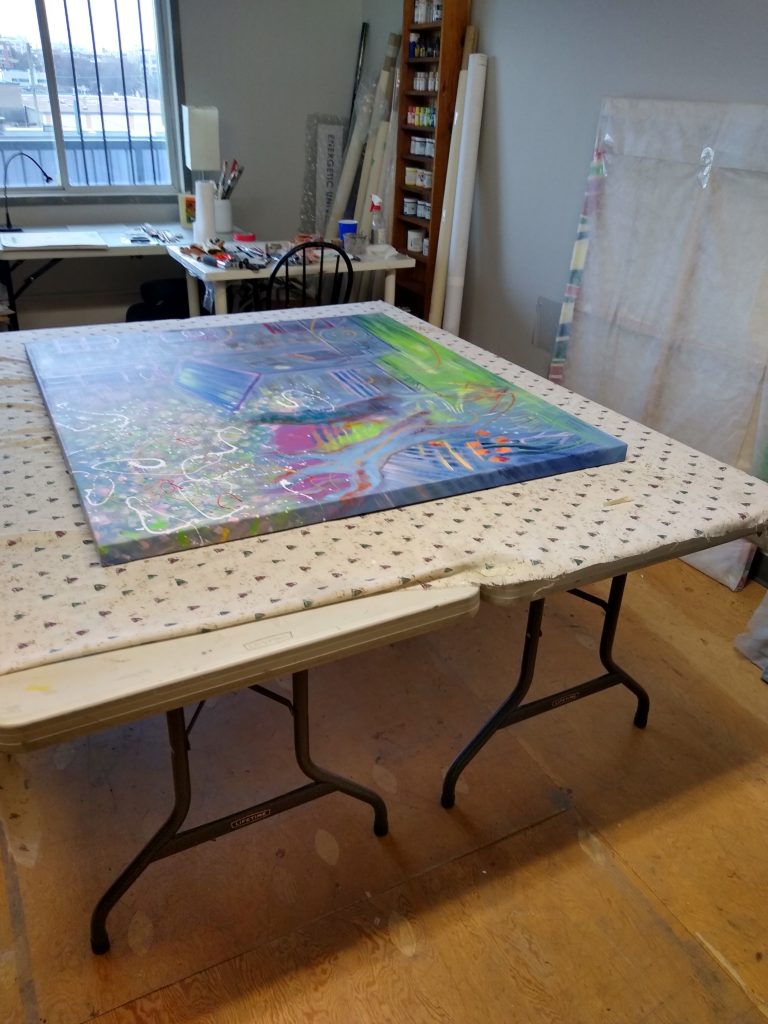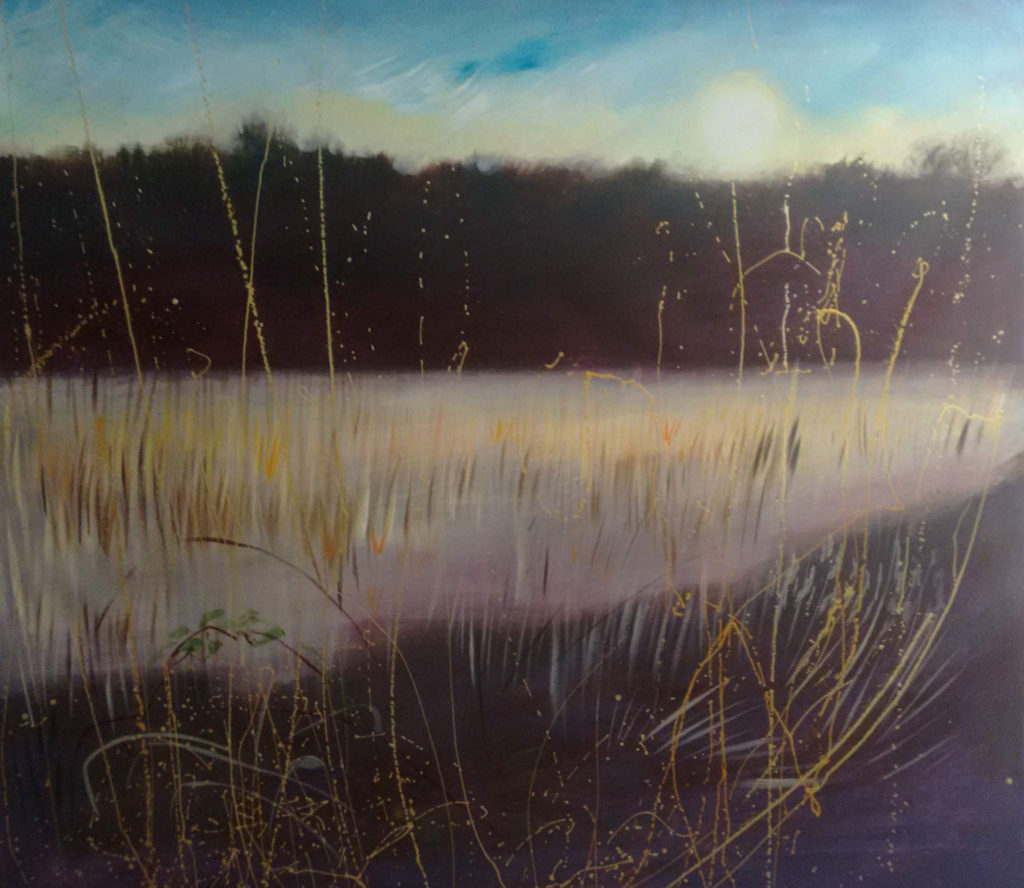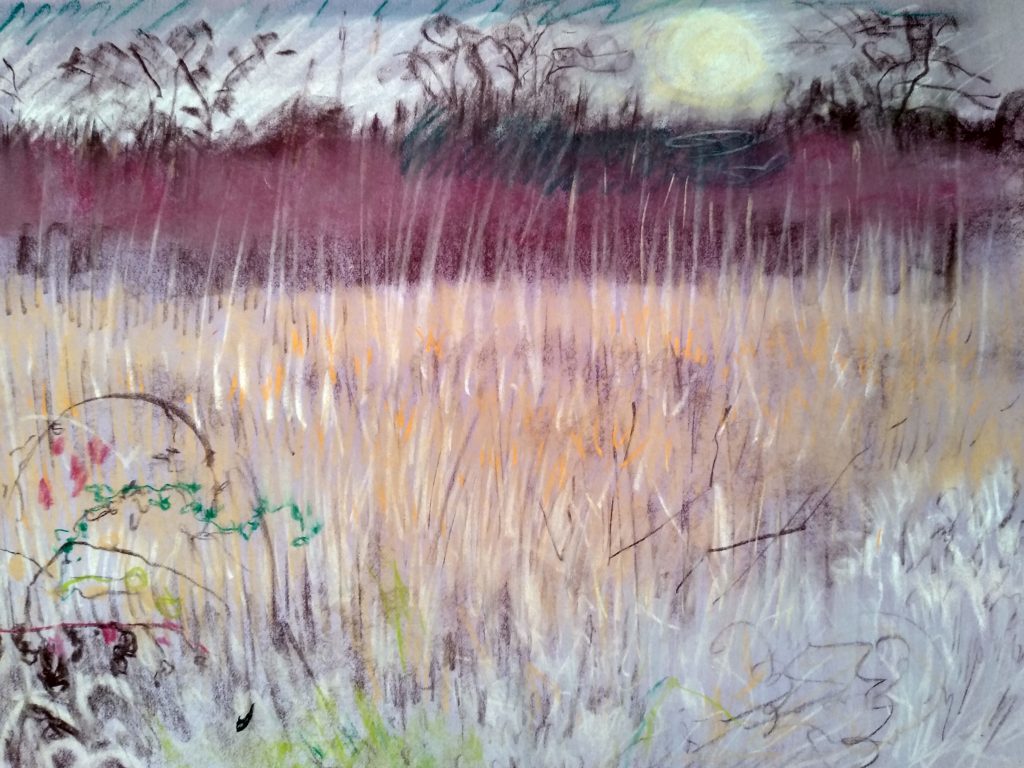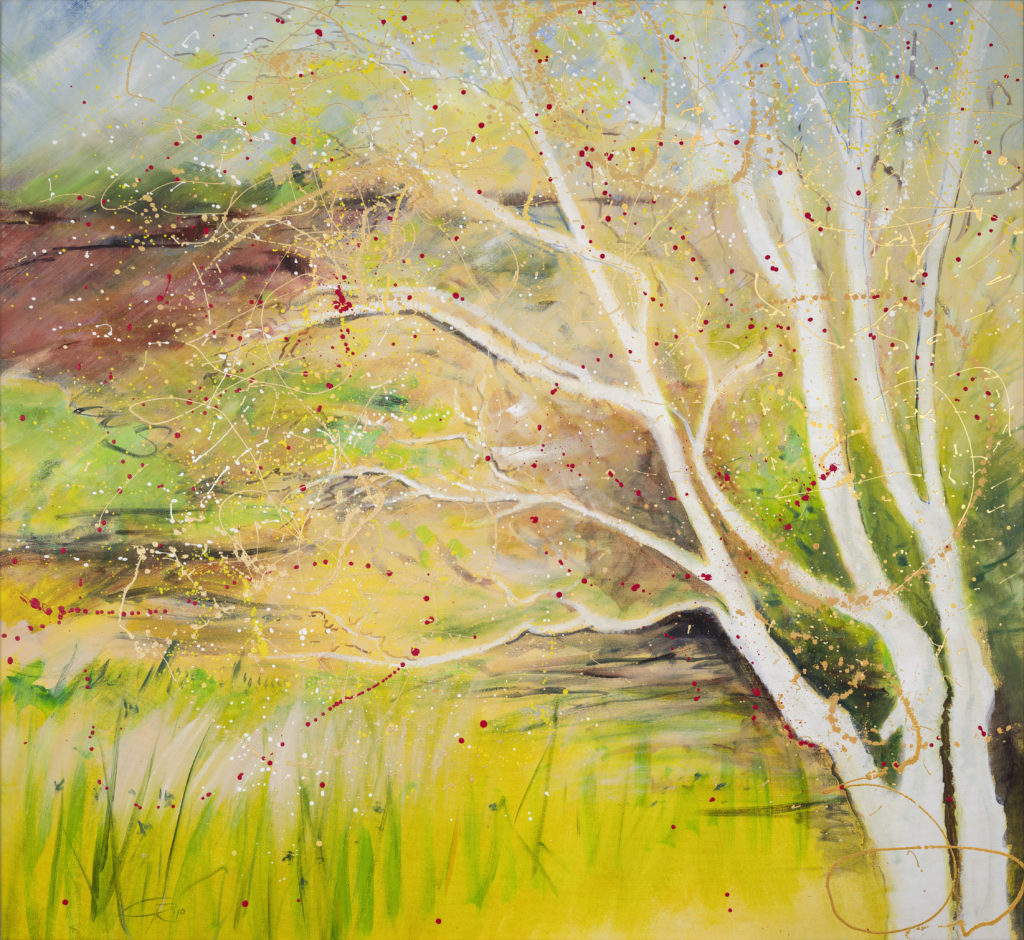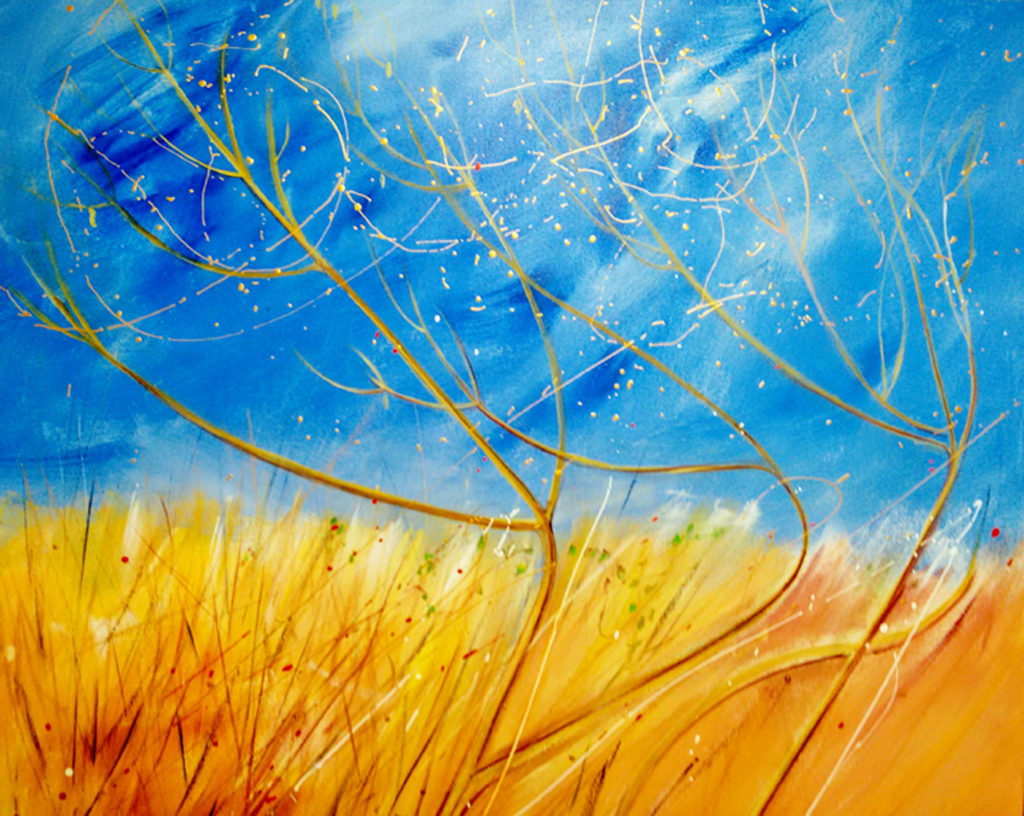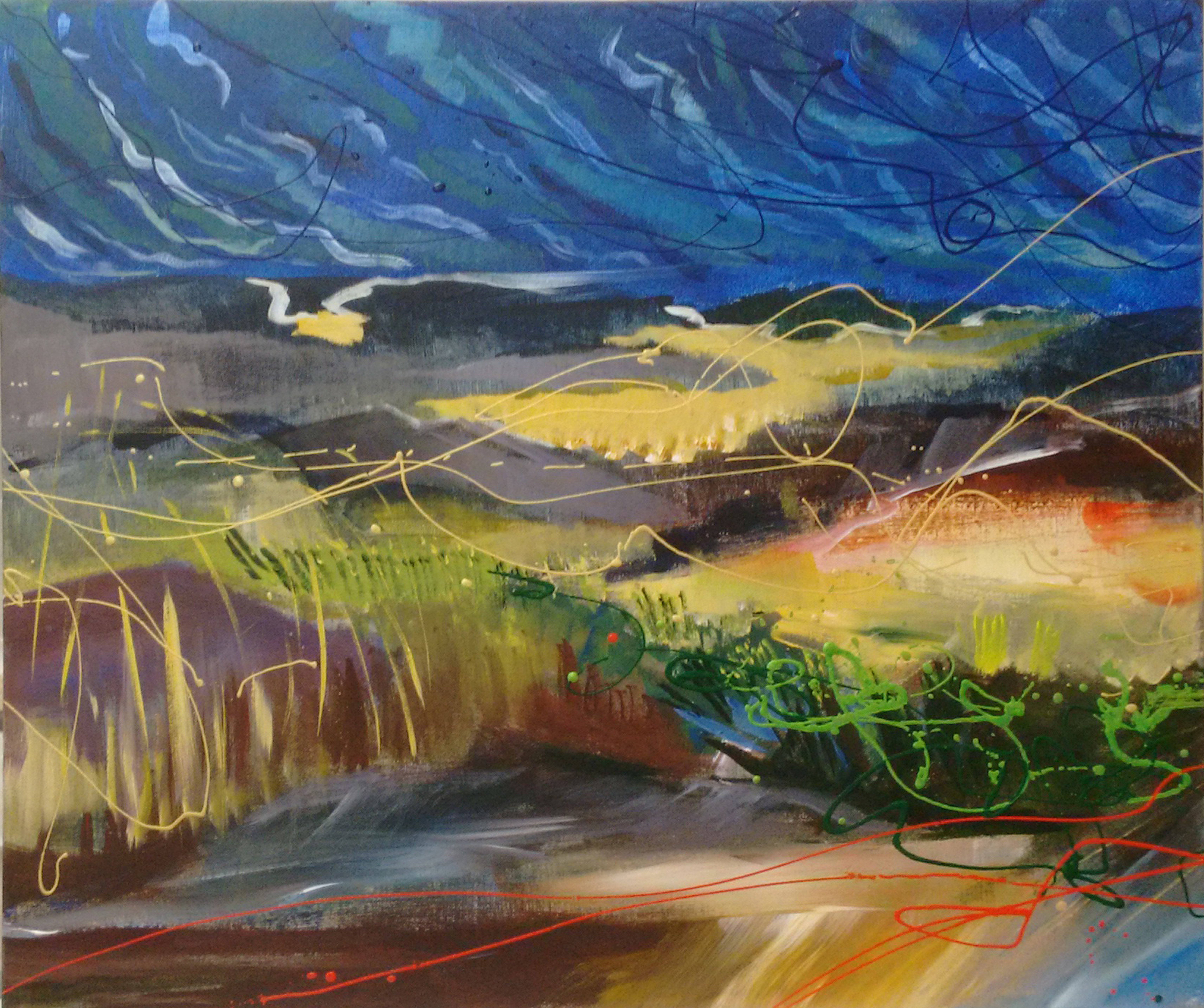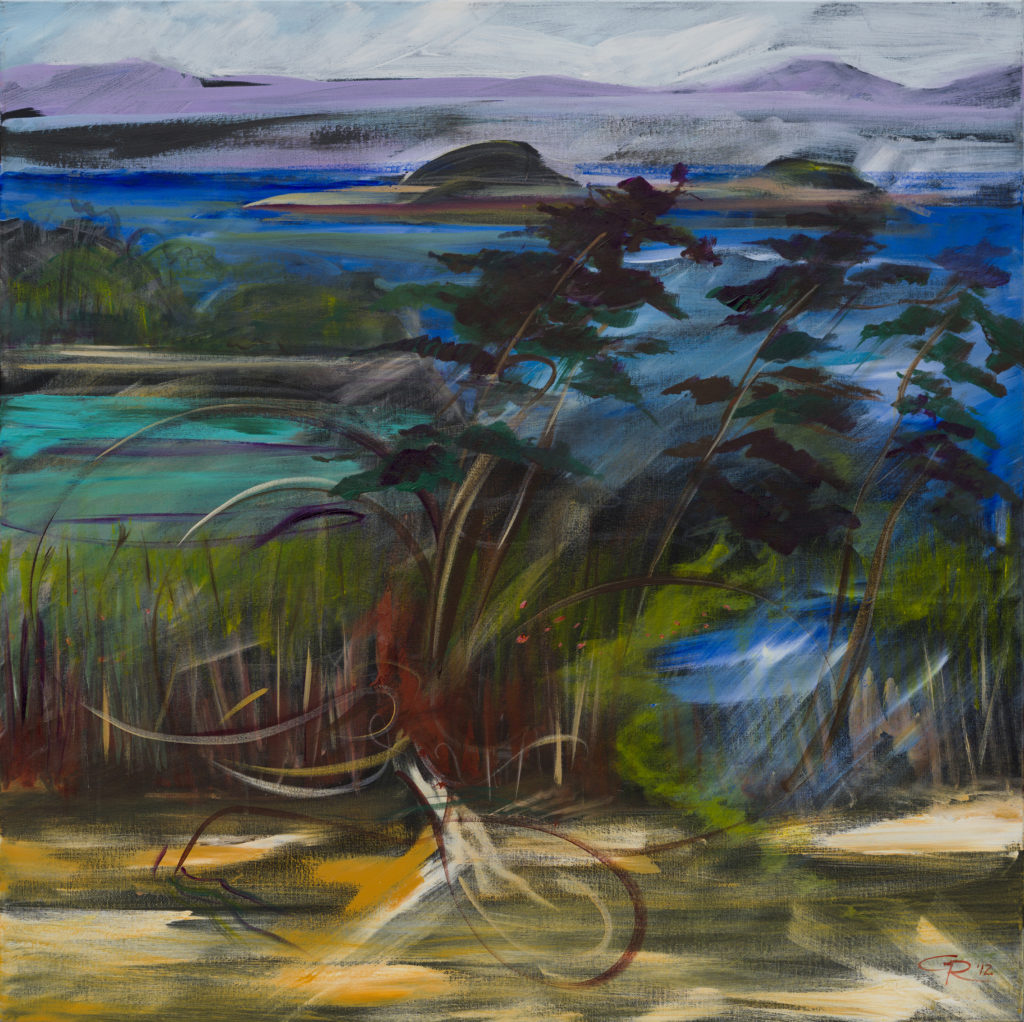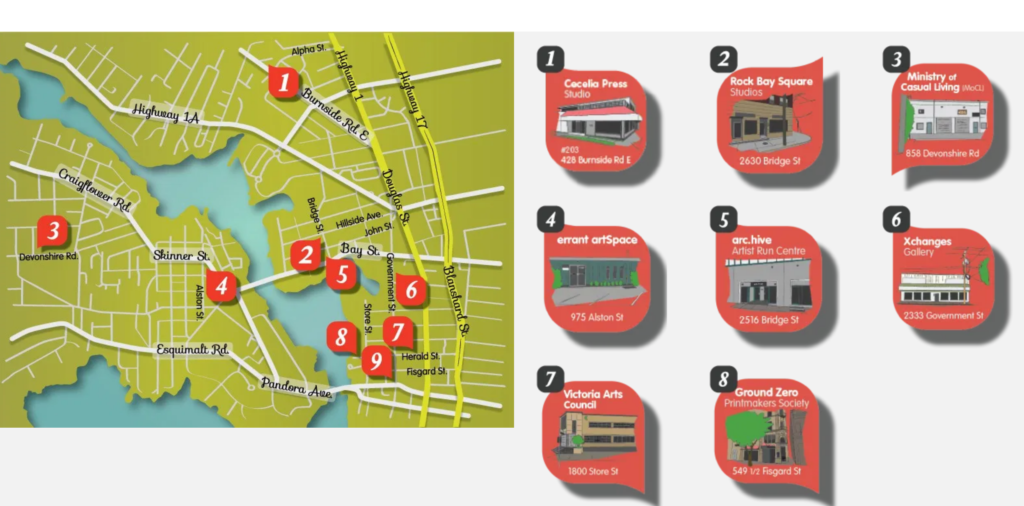Sinixt Mountain Caribou Story
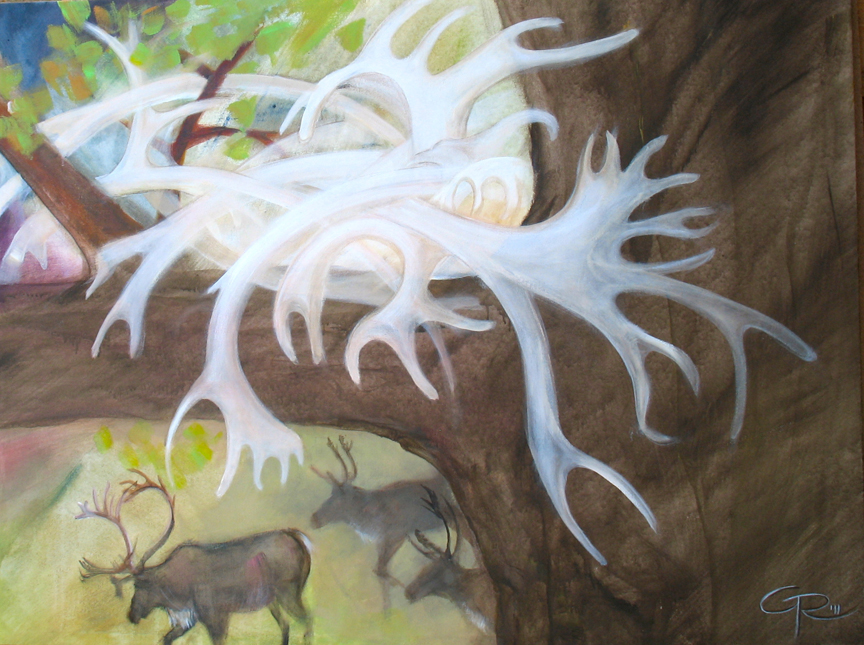
‘Mountain Caribou Story I’ 30H x 40W inches
I heard this story read to a small group of people in the Community Garden in Nakusp. It related the memories of a teenage Sinixt boy in the early 20th Century, traveling with his father and uncles from the USA up to the Columbia Basin Valley near Revelstoke. They came to pan for gold to buy food and provisions for the winter.
The story relates how the young boy wandered through Cottonwood groves hunting game, when suddenly a grouse flew up into the canopy of the trees, and following its’ flight with his gun he was amazed by the sight of hundreds, thousands of caribou antlers banked like arches of a cathedral in the branches of the trees above his head.
In those days, and for perhaps thousands of years, Sinixt hunters had laid hides and blankets on the branches of the cottonwood trees, and in these antler nests they waited for the migrating caribou. This carefully resourced wild food was their winter staple source of protein while salmon from the Columbia River provided for the Spring and Fall.
Many years later, returning from fighting in Europe during WWII the youth, now a grown man wished to return to the area that had held his memories and spirit during the war years. On arriving in the valley in the early 1950s he found no sign of the cottonwood trees or the forest which had been clear cut for extending the farming land in the Columbia River Valley. Locals told of the sale of large bundles of caribou antlers in the local markets, relics of the traditions and hunting culture of the indigenous Sinixt First Nations in the area.
At the time of hearing this story, I was told that the ‘young man’ of the story was now over ninety years old and living in a Sinixt settlement in northern USA.
With the decimation of the caribou by farming and mining interests, herds are now reduced to a mere twenty pairs in the Selkirk mountains. A Caribou Park has been designated for the area, to protect what remains of their old growth habitat.
This project tells the story of this young man’s incredible discovery. The Nakusp Museum produced a DVD of the story told by a Sinixt elder. An audio soundtrack is available.
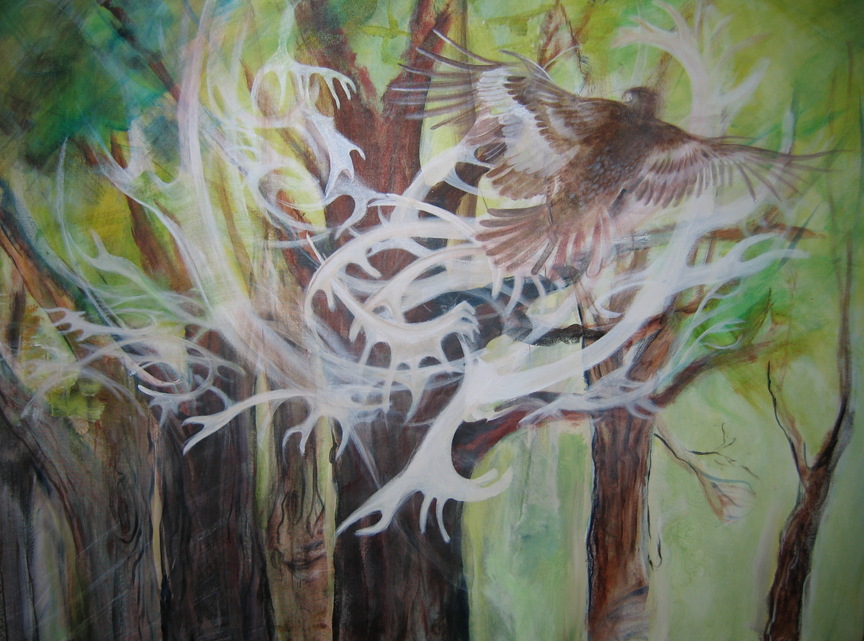
‘Mountain Caribou Story II’ 30H x 40W inches
……………………
Historian Eileen Delehanty Pearkes has provided a summary of historical references to the Sinixt people in the area of this park proposal:“The use of the north end of upper Arrow Lake and its surrounding watershed (Trout Lake, Incomappleux River, Lardeau River and north end of Kootenay Lake by Arrow Lakes Indians (Sinixt) is well documented in the ethnographic literature. Several relevent place names confirm the importance of this area to the cultural traditions of this Interior Salish tribe.“nk’mapeleks was a large village somewhere around the head ofBeaton Arm (near the mouth of the Incomappleux River or BeatonCreek). Today, the village site is flooded by the water of the ArrowLakes Reservoir. nk’mapeleks is an ancient term widely anglicized today as Comaplix. The Incomappleux River is a French derivative dating from the Fur Trade. James Teit was told that this village had a large population and was important for fishing, berrying and root-digging.
The Central Selkirk Mountain Caribou herd was estimated at 211 in 1996. By 2002 it was down to 97. The estimate was 89-92 animals. It is more endangered than herds to the north in the Cariboo Mountains and Robson Valley, but less endangered than its immediate neighbours. And it has more habitat left to protect than its neighbours.
Valhalla Wilderness Society
Valhalla Wilderness Society have been champions of BC wildlife conservation since 1975. VWS is a BC wilderness conservation organization specializing in the creation of parks and protected areas for wildlife and ecosystems.
In 2011 they published a 28 page Report full of maps and colour photographs to support the creation of a “Safe Zone’ for the endangered Mountain Caribou.
A population of about 30 endangered mountain caribou, primeval Inland Temperate Rainforest with trees up to 1,800 years old, hundreds of species of lichens, rare plants, core habitat for blue-listed grizzly bears and wolverines, and spawning grounds of the bull trout of Kootenay Lake and the Arrow Lakes Reservoir is all part of the Selkirk Mountain Caribou Park Proposal.
Mountain caribou are endangered because the old-growth forest is endangered. In losing our old-growth, we are also losing other old-growth dependent species. For instance, many species of rainforest lichens in the Central Selkirks are dependent upon old-growth forest.
67% of the Inland Rainforest Region is forest, but only 17% of the region is old-growth forest that is intact (continuous for 1,000 hectares or more). About 16% of the region is in protected areas, but only 4.5% of the region is protected, intact, old-growth forest.
The Valhalla Wilderness Society proposal for a Mountain Caribou protected zone was designed to include rare stands of ancient cedar-hemlock forest such as the upper Incomappleux Valley. Recently, nine lichen species new to science were found there. Scientists are studying another 40 potentially new species.
This park was created to protect the animals however increased tourism, heli-skiing and motorized off-road vehicles have impacted the protected area. VWS is now in consultation with the B.C. Government to increase protection and work alongside tourism operators to further protect the area.
Valhalla Wilderness Society is largely funded by individual donations, plus wilderness conservation and environmental grants.
